A Quantitative Analysis of Firefighter Availability and Prescribed Burning in the Okanogan–Wenatchee National Forest
Abstract
1. Introduction
2. Materials and Methods
2.1. Data
2.2. Methods
- Principal Component Analysis (PCA)
- 2.
- Logistic Regression Model
3. Results
3.1. Principal Component Analysis (PCA)
3.1.1. Burn and Non-Burn Days (Spring and Fall)
3.1.2. Burn Days (Spring and Fall)
3.2. Logistic Regression Model
3.2.1. Fall Days
3.2.2. Spring Days
3.2.3. Combined Fall and Spring Days
4. Discussion
5. Conclusions
Author Contributions
Funding
Institutional Review Board Statement
Informed Consent Statement
Data Availability Statement
Acknowledgments
Conflicts of Interest
Disclaimer
Appendix A
Summary Statistics
| Variable | Mean | Standard Deviation | Median | Minimum | Maximum | n |
|---|---|---|---|---|---|---|
| Total Personnel Unavailable | 84.80 | 139.71 | 29 | 0 | 842 | 2184 |
| Acres of Active Wildfire (NWCC) | 80,116.42 | 224,249.51 | 0 | 0 | 1,578,520 | 2143 * |
| National PL | 1.57 | 0.98 | 1 | 1 | 5 | 2184 |
| NWCC PL | 1.44 | 0.96 | 1 | 1 | 5 | 2143 * |
| FM100 | 16.4 | 4.6 | 15.96 | 6.51 | 28.28 | 2184 |
| FM1000 | 19.80 | 5.34 | 19.83 | 8.33 | 32.85 | 2184 |
| Ventilation Index (m2/s) | 2855.10 | 3148.44 | 1678.52 | 21.69 | 25,352.58 | 2184 |
| Prescribed Burn Days | Non-Prescribed Burn Days | Total | |
|---|---|---|---|
| Spring | 49 | 1043 | 1092 |
| Fall | 28 | 1064 | 1092 |
| Total | 77 | 2107 | 2184 |
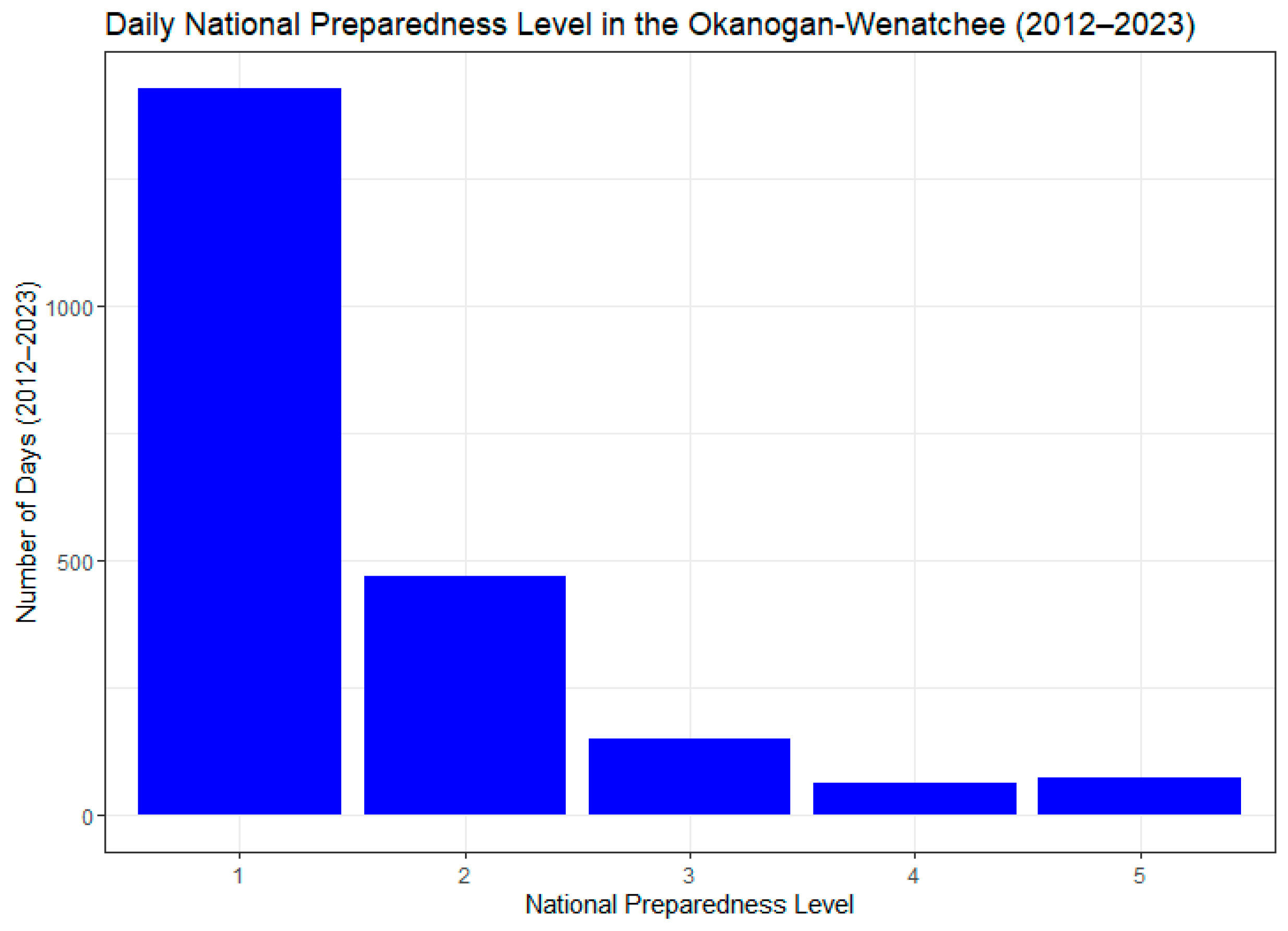
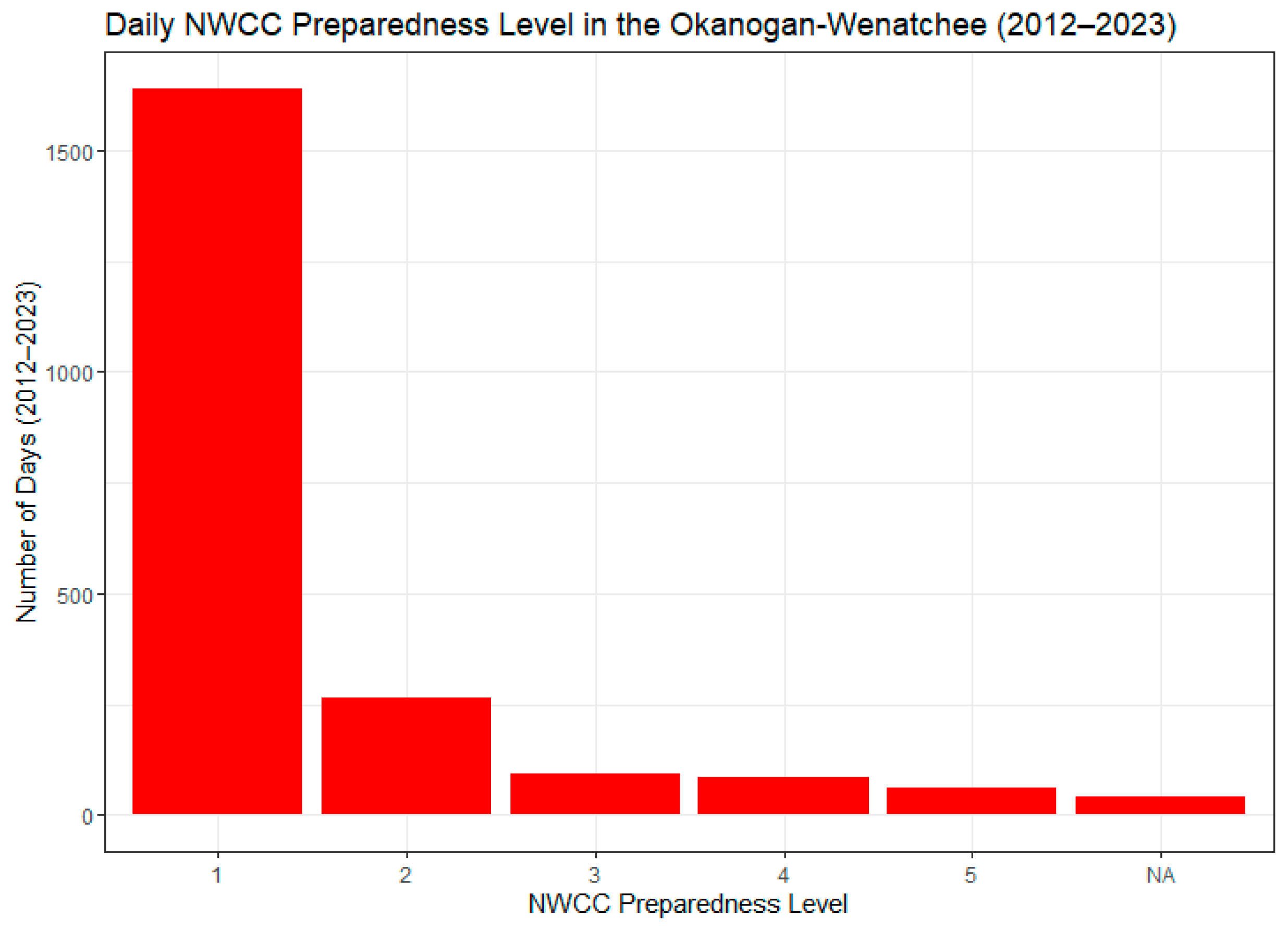
Appendix B
Additional PCA Analyses
- (1)
- All Days in Fall, Spring, and Summer
| PC1 | PC2 | PC3 | PC4 | |
| Proportion of Variance | 0.473 | 0.196 | 0.1 | 0.08 |
| Loadings | ||||
| PC1 | PC2 | PC3 | PC4 | |
| Total Personnel Unavailable | 0.37 | 0.035 | 0.023 | 0.078 |
| Acres of Active Wildfire (NWCC) | 0.268 | 0.335 | 0.545 | −0.044 |
| National PL | 0.419 | 0.078 | 0.187 | 0.029 |
| NWCC PL | 0.394 | 0.151 | 0.272 | 0.045 |
| FM100 | −0.333 | 0.283 | 0.069 | −0.16 |
| FM1000 | −0.399 | 0.085 | 0.117 | 0.006 |
| Ventilation Index | 0.086 | −0.383 | 0.159 | −0.902 |
| March/April/May | −0.279 | −0.331 | 0.593 | 0.218 |
| June/July/August | 0.323 | −0.313 | −0.393 | 0.088 |
| Sept/Oct/Nov | −0.039 | 0.645 | −0.208 | −0.307 |
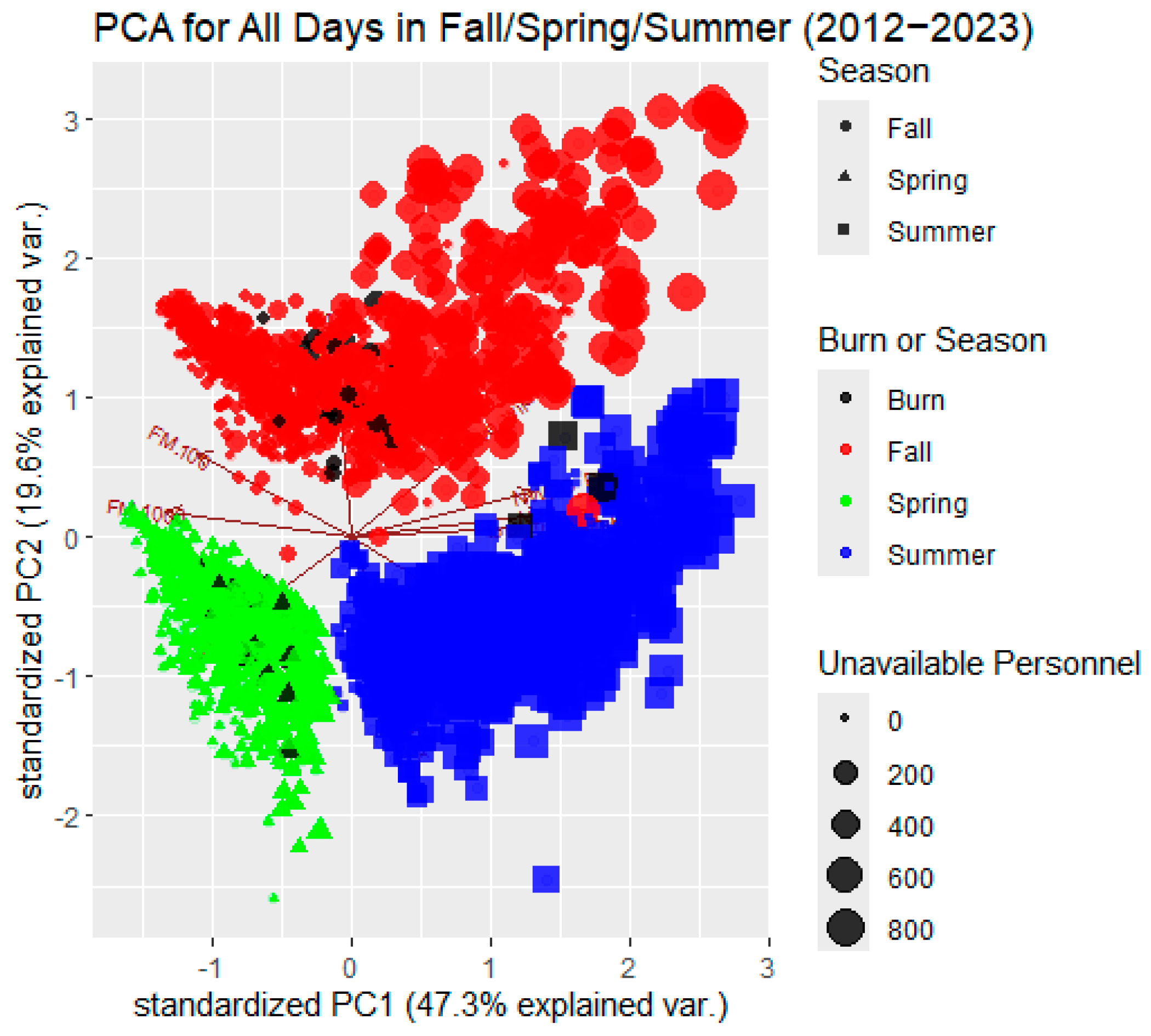
- (2)
- Burn Days in Fall, Spring, and Summer
| PC1 | PC2 | PC3 | PC4 | |
| Proportion of Variance | 0.433 | 0.199 | 0.124 | 0.087 |
| Loadings | ||||
| PC1 | PC2 | PC3 | PC4 | |
| Total Personnel Unavailable | 0.404 | 0.149 | −0.061 | 0.069 |
| Acres of Active Wildfire (NWCC) | 0.362 | −0.063 | −0.201 | 0.118 |
| National PL | 0.366 | 0.181 | −0.237 | 0.051 |
| NWCC PL | 0.414 | 0.053 | −0.093 | −0.035 |
| FM100 | −0.082 | −0.408 | −0.605 | 0.397 |
| FM1000 | −0.357 | −0.0002 | −0.527 | 0.099 |
| Ventilation Index | −0.077 | 0.257 | 0.344 | 0.89 |
| March/April/May | −0.324 | 0.473 | −0.15 | −0.097 |
| June/July/August | 0.371 | 0.269 | −0.194 | 0.054 |
| Sept/Oct/Nov | 0.135 | −0.64 | 0.262 | 0.071 |

- (3)
- All Spring Days
| PC1 | PC2 | PC3 | PC4 | |
| Proportion of Variance | 0.34 | 0.157 | 0.146 | 0.134 |
| Loadings | ||||
| PC1 | PC2 | PC3 | PC4 | |
| Total Personnel Unavailable | 0.454 | −0.143 | −0.151 | 0.206 |
| Acres of Active Wildfire (NWCC) | 0.216 | −0.314 | 0.456 | 0.296 |
| National PL | 0.431 | −0.439 | −0.152 | 0.112 |
| NWCC PL | 0.048 | 0.692 | −0.244 | 0.636 |
| FM100 | −0.507 | −0.303 | −0.149 | 0.363 |
| FM1000 | −0.543 | −0.279 | −0.189 | 0.18 |
| Ventilation Index | 0.084 | −0.202 | 0.793 | 0.538 |

- (4)
- All Fall Days
| PC1 | PC2 | PC3 | PC4 | |
| Proportion of Variance | 0.613 | 0.153 | 0.117 | 0.047 |
| Loadings | ||||
| PC1 | PC2 | PC3 | PC4 | |
| Total Personnel Unavailable | −0.389 | 0.316 | 0.101 | −0.811 |
| Acres of Active Wildfire (NWCC) | −0.376 | 0.455 | 0.124 | 0.126 |
| National PL | −0.447 | 0.183 | 0.086 | 0.302 |
| NWCC PL | −0.446 | 0.075 | 0.003 | 0.441 |
| FM100 | 0.338 | 0.475 | 0.474 | 0.195 |
| FM1000 | 0.4 | 0.374 | 0.287 | −0.031 |
| Ventilation Index | −0.184 | −0.537 | 0.813 | −0.055 |
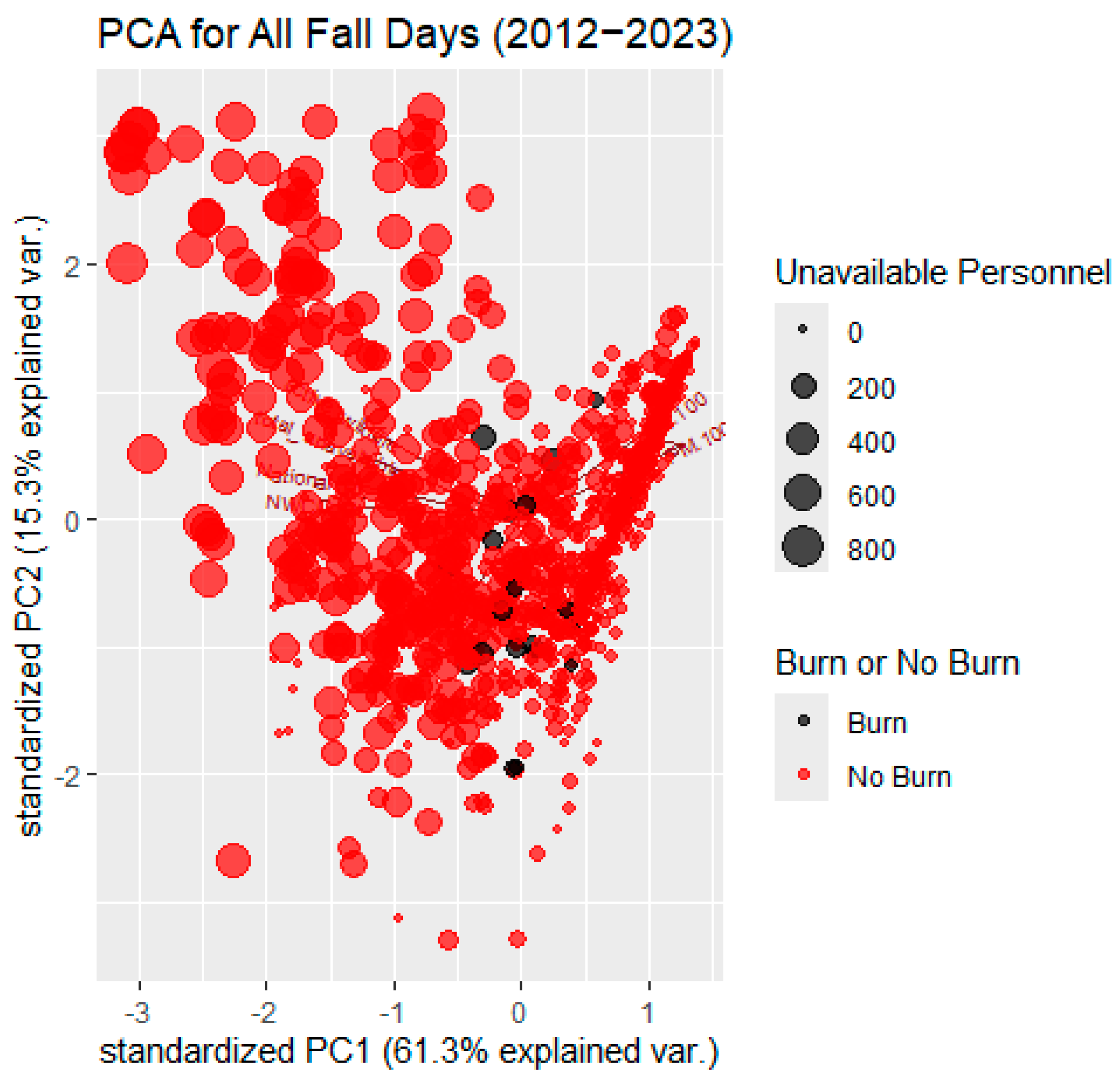
Appendix C
Analyses Using VIIRS Dates
- Principal Component Analysis (PCA)
- 1.1
- Burn and Non-Burn Days (Spring/Fall)
| PC1 | PC2 | PC3 | PC4 | |
| Proportion of Variance | 0.522 | 0.182 | 0.116 | 0.079 |
| Loadings | ||||
| PC1 | PC2 | PC3 | PC4 | |
| Total Personnel Unavailable | 0.416 | −0.1 | −0.184 | 0.189 |
| Acres of Active Wildfire (NWCC) | 0.403 | −0.17 | −0.273 | 0.31 |
| National PL | 0.451 | −0.027 | −0.155 | 0.11 |
| NWCC PL | 0.449 | −0.05 | −0.085 | 0.013 |
| FM100 | −0.248 | −0.564 | −0.473 | −0.092 |
| FM1000 | −0.374 | −0.329 | −0.361 | 0.271 |
| Ventilation Index | 0.003 | 0.535 | −0.688 | −0.476 |
| Spring/Fall (Spring = 1) | −0.242 | 0.495 | −0.183 | 0.74 |

| PC1 | PC2 | PC3 | PC4 | |
| Proportion of Variance | 0.484 | 0.162 | 0.115 | 0.101 |
| Loadings | ||||
| PC1 | PC2 | PC3 | PC4 | |
| Total Personnel Unavailable | 0.439 | −0.085 | 0.263 | −0.281 |
| Acres of Active Wildfire (NWCC) | 0.355 | −0.351 | 0.03 | −0.401 |
| National PL | 0.353 | 0.088 | 0.341 | −0.388 |
| NWCC PL | 0.419 | −0.01 | −0.192 | 0.329 |
| FM100 | −0.142 | −0.705 | −0.417 | −0.22 |
| FM1000 | −0.445 | −0.206 | 0.085 | −0.28 |
| Ventilation Index | 0.055 | 0.526 | −0.674 | −0.507 |
| Spring/Fall (Spring = 1) | −0.4 | 0.213 | 0.375 | −0.343 |

- 2.
- Logistic Regression Model
| Logit Model for Prescribed Burning in the Okanogan-Wenatchee (2012–2023) with VIIRS/FACTS | ||||||
|---|---|---|---|---|---|---|
| Dependent Variable: Prescribed Burn Day (Yes/No) | ||||||
| Fall β (s.e.) | Fall β (s.e.) | Spring β (s.e.) | Spring β (s.e.) | Fall/Spring β (s.e.) | Fall/Spring β (s.e.) | |
| (Intercept) | −1.2023 (0.7492) | −27.6495 *** (6.5399) | −0.7073 (0.8876) | −33.8075 *** (8.4069) | −1.0271 (0.5423) | −11.3336 *** (2.7688) |
| Total Personnel Unavailable | −0.0031 ** (0.0013) | −0.0038 ** (0.0015) | 0.0001 (0.0040) | 0.0015 (0.0042) | −0.0023 ** (0.0012) | −0.0013 (0.0012) |
| FM1000 | −0.1338 *** (0.0396) | 3.4258 *** (0.8673) | −0.0958 ** (0.0391) | 3.1962 *** (0.8455) | −0.1230 *** (0.0273) | 1.0808 *** (0.2948) |
| (FM1000)2 | - | −0.1146 *** (0.0286) | - | −0.0805 *** (0.0212) | - | −0.0321 *** (0.0079) |
| Ventilation Index | −0.0001 ** (0.00006) | −0.0002 * (0.00007) | −0.00008 * (0.00005) | −0.00005 (0.00004) | −0.00002 (0.00004) | −0.00001 (0.00004) |
| Spring/Fall (Spring = 1) | - | - | - | - | 0.7442 *** (0.2653) | −0.3498 (0.2604) |
| Observations | 1092 | 1092 | 1092 | 1092 | 2184 | 2184 |
| Akaike Inf. Crit. | 282.46 | 244.29 | 428.35 | 401.33 | 713.75 | 689.41 |
References
- Abatzoglou, J.T.; Williams, A.P. Impact of Anthropogenic Climate Change on Wildfire across Western US Forests. Proc. Natl. Acad. Sci. USA 2016, 113, 11770–11775. [Google Scholar] [CrossRef] [PubMed]
- Parks, S.A.; Abatzoglou, J.T. Warmer and Drier Fire Seasons Contribute to Increases in Area Burned at High Severity in Western US Forests From 1985 to 2017. Geophys. Res. Lett. 2020, 47, e2020GL089858. [Google Scholar] [CrossRef]
- Cullen, A.C.; Prichard, S.J.; Abatzoglou, J.T.; Dolk, A.; Kessenich, L.; Bloem, S.; Bukovsky, M.S.; Humphrey, R.; McGinnis, S.; Skinner, H.; et al. Growing Convergence Research: Coproducing Climate Projections to Inform Proactive Decisions for Managing Simultaneous Wildfire Risk. Risk Anal. 2023, 43, 2262–2279. [Google Scholar] [CrossRef]
- Prichard, S.J.; Hessburg, P.F.; Hagmann, R.K.; Povak, N.A.; Dobrowski, S.Z.; Hurteau, M.D.; Kane, V.R.; Keane, R.E.; Kobziar, L.N.; Kolden, C.A.; et al. Adapting Western North American Forests to Climate Change and Wildfires: 10 Common Questions. Ecol. Appl. 2021, 31, 1–30. [Google Scholar] [CrossRef]
- Quinn-Davidson, L.N.; Varner, J.M. Impediments to Prescribed Fire across Agency, Landscape and Manager: An Example from Northern California. Int. J. Wildland Fire 2012, 21, 210–218. [Google Scholar] [CrossRef]
- Kobziar, L.N.; Godwin, D.; Taylor, L.; Watts, A.C. Perspectives on Trends, Effectiveness, and Impediments to Prescribed Burning in the Southern U.S. Forests 2015, 6, 561–580. [Google Scholar] [CrossRef]
- Schultz, C.A.; McCaffrey, S.M.; Huber-Stearns, H.R. Policy Barriers and Opportunities for Prescribed Fire Application in the Western United States. Int. J. Wildland Fire 2019, 28, 874–884. [Google Scholar] [CrossRef]
- Miller, R.K.; Field, C.B.; Mach, K.J. Barriers and Enablers for Prescribed Burns for Wildfire Management in California. Nat. Sustain. 2020, 3, 101–109. [Google Scholar] [CrossRef]
- Smithwick, E.A.H.; Wu, H.; Spangler, K.; Adib, M.; Wang, R.; Dems, C.; Taylor, A.; Kaye, M.; Zipp, K.; Newman, P.; et al. Barriers and Opportunities for Implementing Prescribed Fire: Lessons from Managers in the Mid-Atlantic Region, United States. Fire Ecol. 2024, 20, 77. [Google Scholar] [CrossRef]
- Westerling, A.L. Increasing Western US Forest Wildfire Activity: Sensitivity to Changes in the Timing of Spring. Philos. Trans. R. Soc. Lond. Ser. B Biol. Sci. 2016, 371, 20150178. [Google Scholar] [CrossRef]
- Abatzoglou, J.T.; Battisti, D.S.; Williams, A.P.; Hansen, W.D.; Harvey, B.J.; Kolden, C.A. Projected Increases in Western US Forest Fire despite Growing Fuel Constraints. Commun. Earth Environ. 2021, 2, 227. [Google Scholar] [CrossRef]
- Hessburg, P.F.; Prichard, S.J.; Hagmann, R.K.; Povak, N.A.; Lake, F.K. Wildfire and Climate Change Adaptation of Western North American Forests: A Case for Intentional Management. Ecol. Appl. 2021, 31, e02432. [Google Scholar] [CrossRef] [PubMed]
- Harry, P.; Alison, C. Patterns and Trends in Simultaneous Wildfire Activity in the United States from 1984 to 2015. Int. J. Wildland Fire 2020, 29, 1057–1071. [Google Scholar] [CrossRef]
- Skinner, H.K.; Prichard, S.J.; Cullen, A.C. Decision Support for Landscapes with High Fire Hazard and Competing Values at Risk: The Upper Wenatchee Pilot Project. Fire 2024, 7, 77. [Google Scholar] [CrossRef]
- Gewers, F.L.; Ferreira, G.R.; De Arruda, H.F.; Silva, F.N.; Comin, C.H.; Amancio, D.R.; Costa, L.D.F. Principal Component Analysis: A Natural Approach to Data Exploration. ACM Comput. Surv. 2022, 54, 1–34. [Google Scholar] [CrossRef]
- Osborne, J.W. Best Practices in Logistic Regression; SAGE: Los Angeles, CA, USA, 2015. [Google Scholar]
- USFS. Hazardous Fuel Treatment Reduction—Polygon. 2024. Available online: https://data.fs.usda.gov/geodata/edw/datasets.php (accessed on 9 November 2024).
- Abatzoglou, J.T. Development of Gridded Surface Meteorological Data for Ecological Applications and Modelling. Int. J. Climatol. 2013, 33, 121–131. [Google Scholar] [CrossRef]
- ERA5. ECMWF Reanalysis v5. 2024. Available online: https://www.ecmwf.int/en/forecasts/dataset/ecmwf-reanalysis-v5 (accessed on 14 October 2024).
- Nguyen, D.; Belval, E.J.; Wei, Y.; Short, K.C.; Calkin, D.E. Dataset of United States Incident Management Situation Reports from 2007 to 2021. Sci. Data 2024, 11, 23. [Google Scholar] [CrossRef]
- Cullen, A.C.; Axe, T.; Podschwit, H. High-Severity Wildfire Potential—Associating Meteorology, Climate, Resource Demand and Wildfire Activity with Preparedness Levels. Int. J. Wildland Fire 2021, 30, 30–51. [Google Scholar] [CrossRef]
- IROC. Interagency Resource Ordering Capability. 2024. Available online: https://www.wildfire.gov/application/iroc (accessed on 4 November 2024).
- ROSS. Resource Ordering and Status System. Lockheed Martin Enterprise Solutions & Services. 2024. Available online: https://www.wildfire.gov/application/ross (accessed on 4 November 2024).
- Belval, E.J.; Stonesifer, C.S.; Calkin, D.E. Fire Suppression Resource Scarcity: Current Metrics and Future Performance Indicators. Forests 2020, 11, 217. [Google Scholar] [CrossRef]
- Washington State Department of Natural Resources (WA DNR). Join Our Seasonal Firefighting Team. Available online: https://www.dnr.wa.gov/wildfirejobs (accessed on 14 February 2025).
- Fossum, C.A.; Collins, B.M.; Stephens, C.W.; Lydersen, J.M.; Restaino, J.; Katuna, T.; Stephens, S.L. Trends in Prescribed Fire Weather Windows from 2000 to 2022 in California. For. Ecol. Manag. 2024, 562, 121966. [Google Scholar] [CrossRef]
- Knapp, E.E.; Estes, B.L.; Skinner, C.N. Ecological Effects of Prescribed Fire Season: A Literature Review and Synthesis for Managers. JFSP Synth. Rep. 2009, 4. Available online: http://digitalcommons.unl.edu/jfspsynthesis/4 (accessed on 7 April 2025).
- Podschwit, H.; Miller, C.; Alvarado, E. Spatiotemporal Prescribed Fire Patterns in Washington State, USA. Fire 2021, 4, 19. [Google Scholar] [CrossRef]
- Monsanto, P.G.; Agee, J.K. Long-Term Post-Wildfire Dynamics of Coarse Woody Debris After Salvage Logging and Implications for Soil Heating in Dry Forests of the Eastern Cascades, Washington. For. Ecol. Manag. 2008, 255, 3952–3961. [Google Scholar] [CrossRef]
- FIRMS. Fire Information for Research Management System. VIIRS S-NPP. 2025. Available online: https://firms.modaps.eosdis.nasa.gov/download/ (accessed on 22 February 2025).

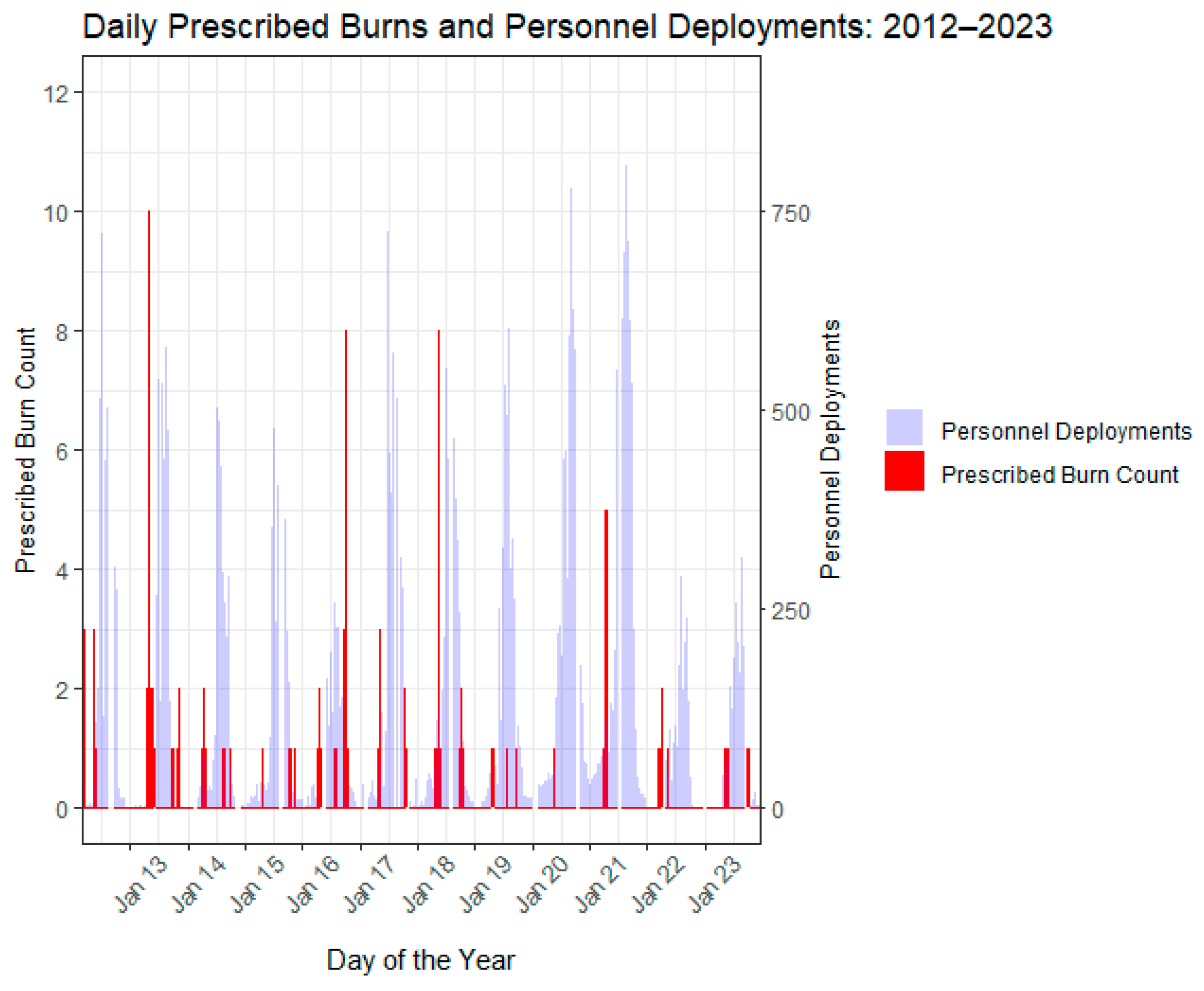
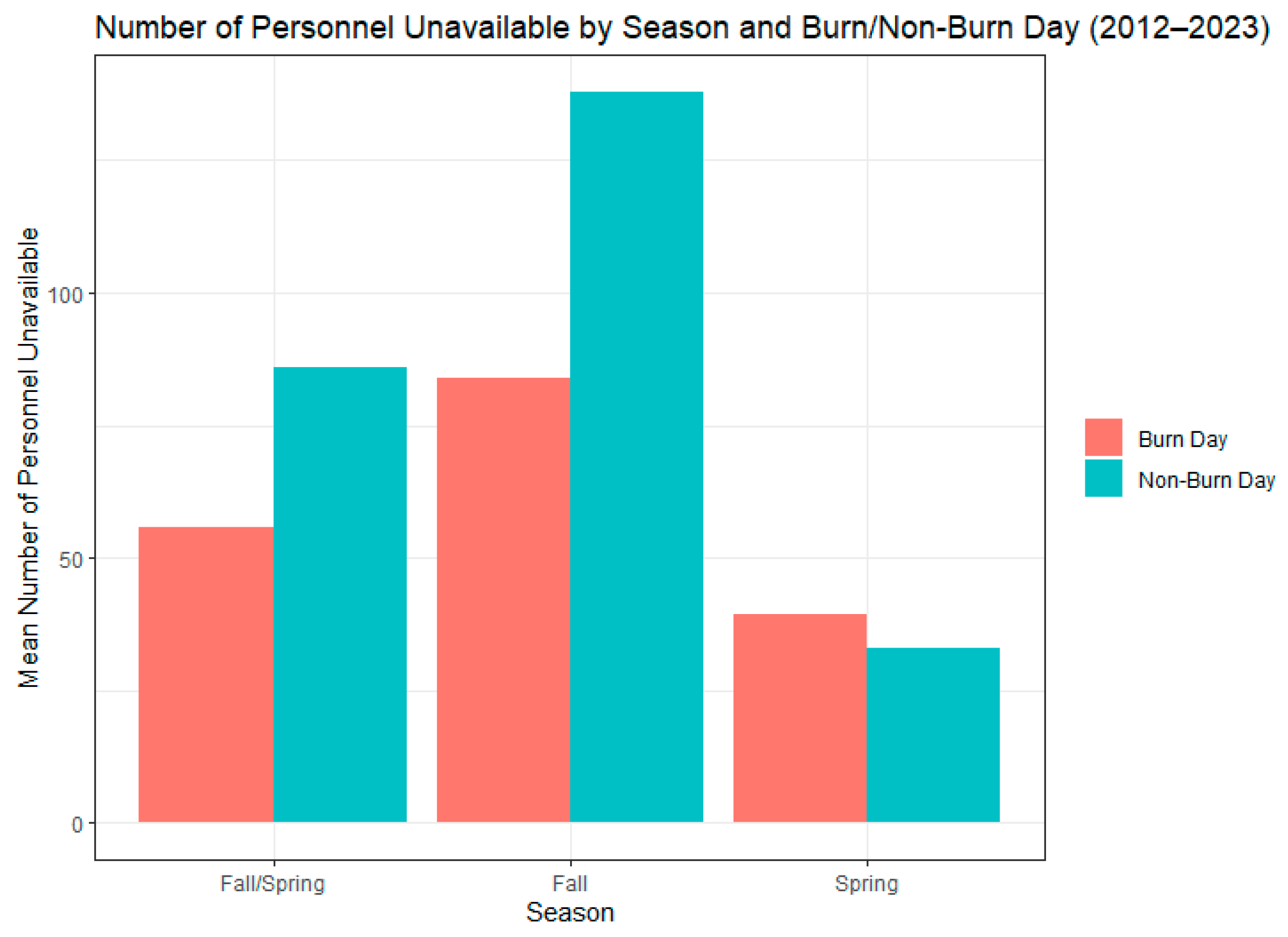


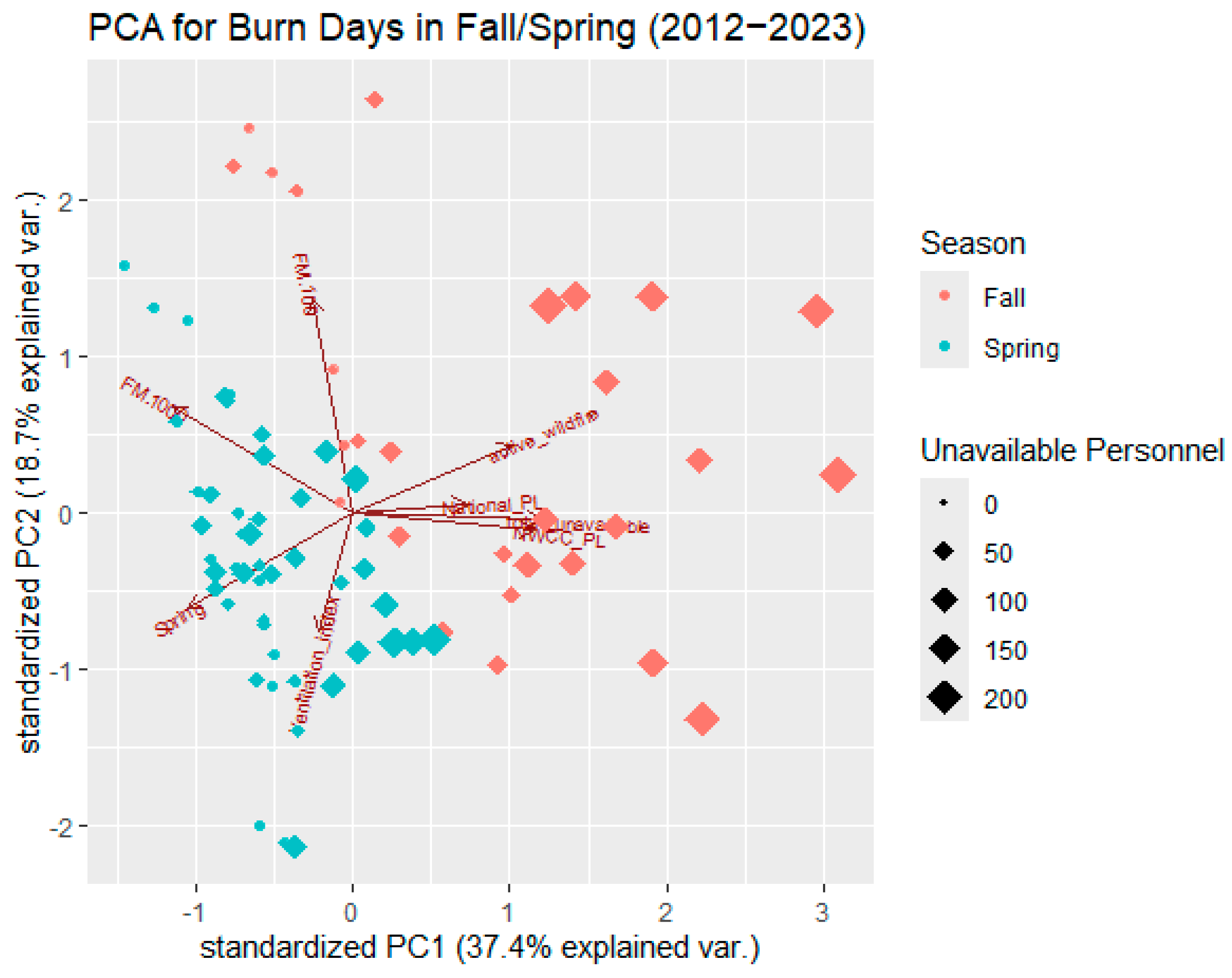
| Variable | Description | Source |
|---|---|---|
| Prescribed Burn Day (Yes/No) | A binary variable coded as 1 on days on which there was at least one prescribed burn in the Okanogan–Wenatchee National Forest and 0 on days on which there were no prescribed burns in the forest. | USFS Hazardous Fuel Treatment Reduction—Polygon (2024) [17] |
| Total Personnel Unavailable | The total number of personnel already deployed on a given day, including crew, air, equipment, and overhead personnel from the Okanogan–Wenatchee National Forest, other national forests in Washington, and Washington state resources. | IROC (2024) [22] ROSS (2024) [23] |
| FM100 | Mean 100 h fuel moisture percentage across the Okanogan–Wenatchee National Forest on a given day. | GridMET (Abatzoglou 2013) [18] |
| FM1000 | Mean 1000 h fuel moisture percentage across the Okanogan–Wenatchee National Forest on a given day. | GridMET (Abatzoglou 2013) [18] |
| Ventilation Index | The smoke ventilation index on a given day, calculated at time 22Z using the mixing height and transport wind at 48.25 N, 121.25 W. | ERA5 (2024) [19] |
| National PL | The national preparedness level (PL) on a given day. Coded on a scale of 1 to 5, with 5 indicating the highest level of national resources committed. | US Incident Management Situation Reports (IMSRs) Nguyen et al. (2024) [20] |
| NWCC PL | The regional preparedness level on a given day. | US Incident Management Situation Reports (IMSRs) Nguyen et al. (2024) [20] |
| Acres of Active Wildfire (NWCC) | The total number of acres of active wildfire burning in the NWCC on a given day. | US Incident Management Situation Reports (IMSRs) Nguyen et al. (2024) [20] |
| PC1 | PC2 | PC3 | PC4 | |
| Proportion of Variance | 0.522 | 0.182 | 0.116 | 0.079 |
| Loadings | ||||
| PC1 | PC2 | PC3 | PC4 | |
| Total Personnel Unavailable | 0.416 | −0.1 | −0.184 | 0.189 |
| Acres of Active Wildfire (NWCC) | 0.403 | −0.17 | −0.273 | 0.31 |
| National PL | 0.451 | −0.027 | −0.155 | 0.11 |
| NWCC PL | 0.449 | −0.05 | −0.085 | 0.013 |
| FM100 | −0.248 | −0.564 | −0.473 | −0.092 |
| FM1000 | −0.374 | −0.329 | −0.361 | 0.271 |
| Ventilation Index | 0.003 | 0.535 | −0.688 | −0.476 |
| Spring/Fall (Spring = 1) | −0.242 | 0.495 | −0.183 | 0.74 |
| PC1 | PC2 | PC3 | PC4 | |
| Proportion of Variance | 0.374 | 0.187 | 0.138 | 0.11 |
| Loadings | ||||
| PC1 | PC2 | PC3 | PC4 | |
| Total Personnel Unavailable | 0.458 | −0.024 | 0.368 | 0.064 |
| Acres of Active Wildfire (NWCC) | 0.387 | 0.235 | 0.178 | −0.249 |
| National PL | 0.279 | 0.03 | 0.672 | 0.288 |
| NWCC PL | 0.44 | −0.061 | −0.303 | 0.002 |
| FM100 | −0.097 | 0.73 | 0.101 | −0.321 |
| FM1000 | −0.437 | 0.361 | 0.254 | 0.054 |
| Ventilation Index | −0.084 | −0.409 | 0.284 | −0.833 |
| Spring/Fall (Spring = 1) | −0.403 | −0.33 | 0.367 | 0.226 |
| Logit Model for Prescribed Burning in the Okanogan-Wenatchee (2012–2023) | ||||||
|---|---|---|---|---|---|---|
| Dependent Variable: Prescribed Burn Day (Yes/No) | ||||||
| Fall β (s.e.) | Fall β (s.e.) | Spring β (s.e.) | Spring β (s.e.) | Fall/Spring β (s.e.) | Fall/Spring β (s.e.) | |
| (Intercept) | −1.0806 (0.8006) | −16.4701 *** (4.7213) | −0.4139 (0.9449) | 21.1839 *** (6.8477) | −1.0068 (0.5760) | −13.2504 *** (3.2371) |
| Total Personnel Unavailable | −0.0040 ** (0.0017) | −0.0040 ** (0.0019) | 0.0006 (0.0041) | 0.0017 (0.0042) | −0.0035 ** (0.0015) | −0.0023 (0.0016) |
| FM1000 | −0.1128 *** (0.0395) | 1.8016 *** (0.5661) | −0.1155 *** (0.0423) | 1.9556 *** (0.6893) | −0.1187 *** (0.0284) | 1.2386 *** (0.3453) |
| (FM1000)2 | - | −0.0564 *** (0.0169) | - | −0.0507 *** (0.0173) | - | −0.0357 *** (0.0091) |
| Ventilation Index | −0.000076 (0.0001) | −0.000072 (0.0001) | −0.00009 * (0.00005) | −0.00007 (0.00005) | −0.00009 ** (0.000044) | −0.00007 * (0.000043) |
| Spring/Fall (Spring = 1) | - | - | - | - | 0.7991 *** (0.2738) | 0.3917 (0.2684) |
| Observations | 1092 | 1092 | 1092 | 1092 | 2184 | 2184 |
| Akaike Inf. Crit. | 257.1 | 236.82 | 395.65 | 383.24 | 647.94 | 623.43 |
Disclaimer/Publisher’s Note: The statements, opinions and data contained in all publications are solely those of the individual author(s) and contributor(s) and not of MDPI and/or the editor(s). MDPI and/or the editor(s) disclaim responsibility for any injury to people or property resulting from any ideas, methods, instructions or products referred to in the content. |
© 2025 by the authors. Licensee MDPI, Basel, Switzerland. This article is an open access article distributed under the terms and conditions of the Creative Commons Attribution (CC BY) license (https://creativecommons.org/licenses/by/4.0/).
Share and Cite
Kenig-Ziesler, A.; Cullen, A.C.; Belval, E.J. A Quantitative Analysis of Firefighter Availability and Prescribed Burning in the Okanogan–Wenatchee National Forest. Fire 2025, 8, 167. https://doi.org/10.3390/fire8050167
Kenig-Ziesler A, Cullen AC, Belval EJ. A Quantitative Analysis of Firefighter Availability and Prescribed Burning in the Okanogan–Wenatchee National Forest. Fire. 2025; 8(5):167. https://doi.org/10.3390/fire8050167
Chicago/Turabian StyleKenig-Ziesler, Anna, Alison C. Cullen, and Erin J. Belval. 2025. "A Quantitative Analysis of Firefighter Availability and Prescribed Burning in the Okanogan–Wenatchee National Forest" Fire 8, no. 5: 167. https://doi.org/10.3390/fire8050167
APA StyleKenig-Ziesler, A., Cullen, A. C., & Belval, E. J. (2025). A Quantitative Analysis of Firefighter Availability and Prescribed Burning in the Okanogan–Wenatchee National Forest. Fire, 8(5), 167. https://doi.org/10.3390/fire8050167






